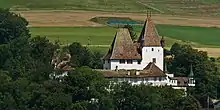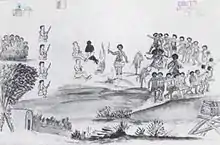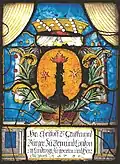Christoph von Graffenried, 1st Baron of Bernberg
Christoph von Graffenried, 1st Baron of Bernberg, also known as Christoph de Graffenried, (15 November 1661 – 1743) was a British peer from Switzerland who founded New Bern, Carolina, in 1710. Today, he is best known for his memoir, Relation of My American Project (c. 1716), which recounts his life as the Baron of Bernburg and Landgrave of Carolina.[1]
Christoph von Graffenried | |
|---|---|
| The Baron of Bernberg | |
| Predecessor | New creation |
| Successor | Anton Tscharner de Graffenried, 2nd Baron of Bernberg |
| Born | 15 November 1661 Worb Castle Bern, Switzerland |
| Died | 1743 (aged 82) |
| Spouse(s) | Regina Tscharner (m. 1684) |
| Father | Anton von Graffenried, Lord of Worb |
| Mother | Catherine von Graffenried |
Early life

Von Graffenried was born on 15 November 1661 to Anton von Graffenried, Lord of Worb, and his first wife, Catherine, at Worb Castle in Bern, Switzerland.[2]
Landgrave of Carolina (1709-1743)
Von Graffenried met Luis Michel, who claimed to know the location of silver ore in Virginia and owned land in the New World. He told von Graffenried what glorious places Carolina and Virginia were, and he advised him to move to Carolina. With the idea of paying off his debts and making money on the cheap land of Carolina, he left his debts to his father and secretly departed for London to make arrangements to move to the New World. When in London, he met with explorer John Lawson, who was publishing a book entitled A Voyage to Carolina. Lawson was the Surveyor General of Carolina. Lawson promised to show von Graffenried and his settlers a perfect place to establish a community. In 1709, von Graffenried next met with the Lords Proprietors of Carolina, who granted to him ten thousand acres (40 km²) on the Neuse and Cape Fear Rivers. They also gave him the title Baron of Bernberg, after the colony he was supposed to found.
Von Graffenried recruited a group of German refugees from the Palatine region, which had been ravaged by French warfare and an extremely harsh winter, and Bernese immigrants. After severe hardships in their own countries, they were willing to try starting over in Carolina. He sailed with the colonists to Carolina in 1710. On the sea, the settlers were attacked by French privateers who stripped them of everything they brought. (On a similar voyage of nearly 3000 German Palatines from London to New York, nearly one-third died during and shortly after the trip; shipboard illnesses killed many already weakened by the harsh conditions of that winter.)

Once in the New World, the settlers sold everything that remained, except the clothes on their backs. John Lawson took them to a site at the junction of the Trent and Neuse Rivers, which they named New Bern. The first season, the settler's crops did not do well. Von Graffenried returned to Europe to get supplies and additional settlers. He returned to the colony unscathed. In addition to a lack of food and supplies, there was great tension between the settlers and the Tuscarora Indians of the Neuse River region. They were separated by language and culture, especially related to their differing concepts of land and property rights. The Tuscarora were an Iroquoian-speaking people, distantly related to the Five Tribes of the Iroquois Confederacy based in central and western New York. The settlers had unwittingly planned their new settlement on the site of an old Tuscarora village. In 1711, von Graffenried and the settlers evicted a group of Tuscarora from nearby lands without payment, and von Graffenried assumed the title "Landgrave of Carolina." Retaliatory raids by the Tuscarora, under a leader named Hancock, led to deaths and damage to the settlement.
During the summer of 1711, von Graffenried, along with John Lawson, took a trip up the Neuse River. Von Graffenried wanted to crossbreed European grapes with wild, native grapes and start a vineyard. The Tuscarora took captive von Graffenried, John Lawson, and an enslaved African whom they had entrusted with their baggage. While in captivity, John Lawson and von Graffenried were given three separate trials, each in a different Tuscaroran village. One found the men not guilty; the other two pronounced them guilty of crimes against the Tuscarora. The Tuscarora decided to kill them but, after extended discussion over several weeks, the elders decided von Graffenried would be released. He wore such fine clothes they mistook him for the Governor of Carolina. They thought if they let the "governor" go, the colony would let the incident pass. They informed him they were planning an attack on all the settlements in northern Carolina (when this took place, it was known as the Tuscarora War). The next day, the natives killed Lawson after ritual torture. Von Graffenried was released on condition that no new European settlements should be made without the sanction of the native chiefs. When he finally reached New Bern, he found it abandoned and in flames.
Journey to the Shenandoah Valley
In 1712 von Graffenried contracted French-Canadian guide and surveyor Martin Chartier to take him to Sugarloaf Mountain[2] and then to the Shenandoah Valley, where they visited Massanutten Mountain, the supposed site of silver ore which the baron hoped to mine, however they found no evidence of any ore.[3]
Later life

Having lost his fortune, von Graffenried returned penniless in 1714 to Worb, Switzerland. He sold his part in Carolina to Thomas Pollock for 800 pounds. Von Graffenried soon wrote a book entitled Relation of My American Project. In it, he included several documents, among them a letter written to the governor of Carolina and a layout of the settlement of New Bern.
In 1731, after the death of a brother, the Oberherr von Worb, [Christoph's father] Anton secured and sold to Christoph the management of the estate which went with the office, reserving for himself the revenues of the office. The management of the estate was not very lucrative, but the father thought he had made a rather generous expiation for his previous treatment. Next, when Anton became Mayor of Murton he wanted a representative in Iverton; and although Christoph did not relish the place, still to please his wife he ran for it and was elected. In 1730 at Anton's death the estate of Worb came to Christoph without encumbrance, and he held it till 1740, when he retired in favor of his sons. Three years later he died and was buried in the choir of the Church at Worb, ending a life the last years of which, while uneventful, were not unpleasant.
Personal life
On 25 April 1684 von Graffenried married Regina Tscharner (1665–1731). Tscharner also came from an accomplished and respected family, her father, Beat Ludwig, having been a member of the Assembly and her grandfather, Samuel, having been the Governor and Mayor of Chillon. The von Graffenrieds had four sons and seven daughters. In 1702, von Graffenried acquired the office of Governor of Yverdon.
References
- Colonial Records of North Carolina. n.d. pp. 985–986. LCCN 01006807. OCLC 2864657 – via Internet Archive.
- Graffenried, Thomas P. de (1925). "Chapter IX: Baron Christopher de Graffenried (The Landgrave)". History of the de Graffenried Family from 1191 A.D. to 1925. Binghamton and New York: Vail-Ballou Press. pp. 58–73. LCCN 26008083. OCLC 660863. OL 24992234M – via Internet Archive.
- The Virginia Magazine of History and Biography, The Virginia Historical Society, Vol. XXX, December, 1922
Further reading
- Faragher, John Mack, ed. (2006). "Graffenried, Christopher, Baron de (1661-1743)". The Encyclopedia of Colonial and Revolutionary America. New York: Facts On File. p. 173. ISBN 0-8160-1744-1. LCCN 88026049.
External links
- Christoph von Graffenried, 1st Baron of Bernberg at Find a Grave
- Christoph von Graffenried, 1st Baron of Bernberg at NCpedia (ncpedia.org)
- Works by or about Christoph von Graffenried at Internet Archive
- Works by or about Christoph von Graffenried, 1st Baron of Bernberg in libraries (WorldCat catalog)
-->
| Regnal titles | ||
|---|---|---|
| New creation | Baron of Bernberg 1709–1743 |
Succeeded by Anton Tscharner de Graffenried |
| New creation | Landgrave of Carolina 1709–1743 | |
| Preceded by Anton von Graffenried |
Lord of Worb 1730–1740 |
Succeeded by Franz Ludwig von Graffenried |